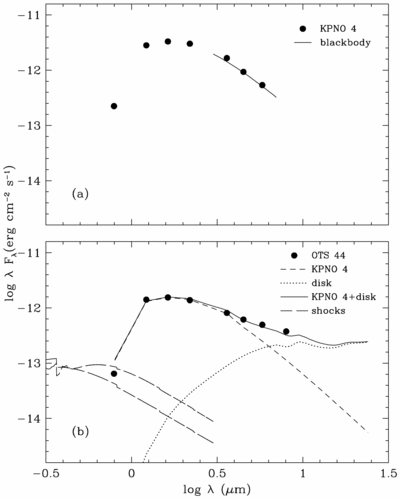Image Details

Caption: Fig. 1.
SEDs of the young brown dwarfs KPNO‐Tau 4 and OTS 44 (filled circles). (a) The slope of the mid‐IR SED of KPNO‐Tau 4 is reproduced by a blackbody at the effective temperature of its stellar photosphere (﹩T_{\mathrm{eff}\,}=2300﹩ K, solid line) and thus exhibits no excess emission from circumstellar material. (b) To estimate the SED of the stellar photosphere of OTS 44, the measured SED of KPNO‐Tau 4 is combined with the blackbody SED at ﹩\lambda > 6﹩ μm and scaled to the H‐band flux of OTS 44 (short‐dashed line). The excess flux above this photospheric SED is modeled in terms of emission from a circumstellar accretion disk (dotted line). The sum of this model disk SED and the photospheric SED agrees fairly well with the data (solid line). The values of the model parameters are ﹩\dot{M}=10^{-10}﹩ M⊙ yr−1, an inclination angle to the line of sight ﹩i=0^{\circ }﹩ (i.e., pole‐on), ﹩\alpha =0.01﹩, and ﹩R_{\mathrm{wall}\,}=3R_{*}﹩. We also include the SEDs predicted for the accretion shock for values of the energy flux that are representative of higher mass T Tauri stars, ﹩\mathstrut{\cal F} =10^{11}﹩ and 1012 ergs cm−2 s−1 (long‐dashed lines).
Copyright and Terms & Conditions
© 2005. The American Astronomical Society. All rights reserved. Printed in U.S.A.



